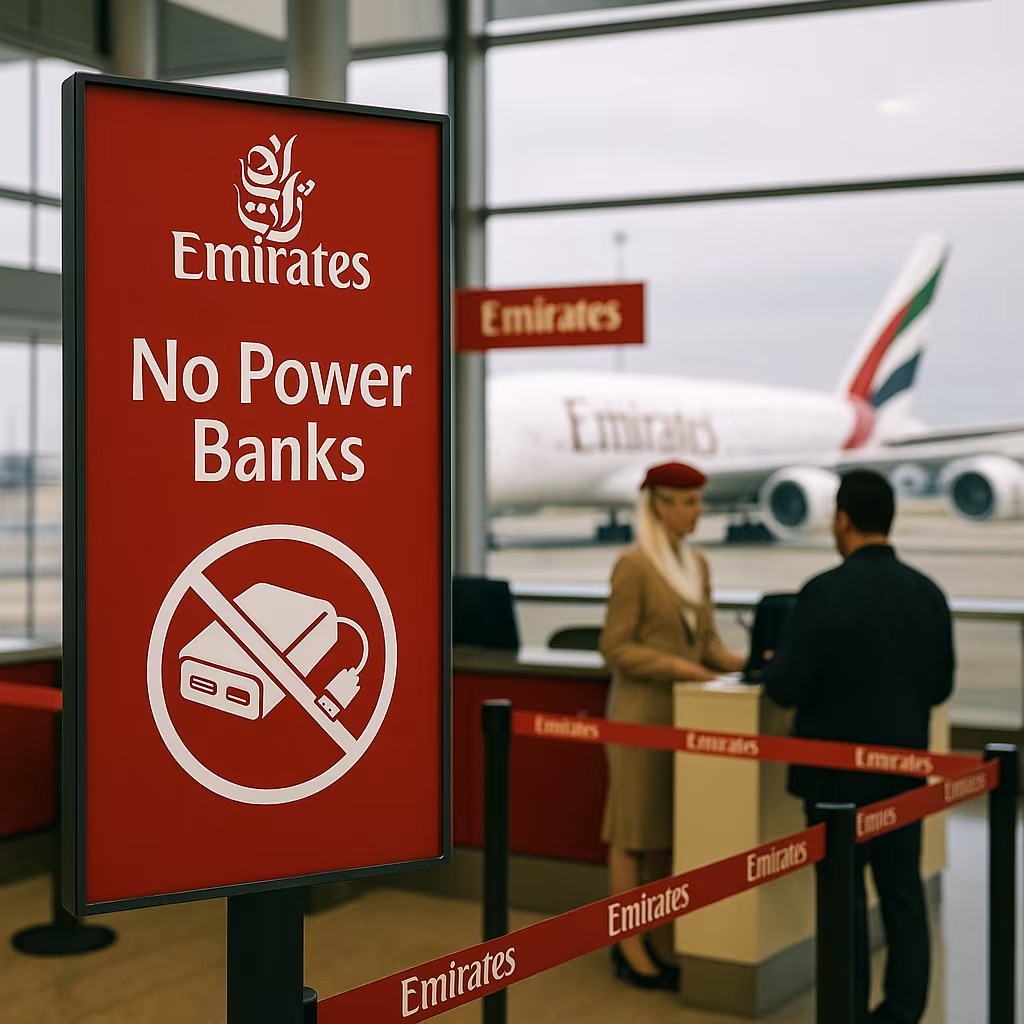Emirates Airlines has introduced a fresh round of restrictions on passenger electronics, this time banning the carriage of power banks in checked and carry-on baggage on certain flights. The decision marks a significant expansion of the airline’s safety measures, reflecting growing concerns over battery-related risks in aviation.
A New Layer of Restrictions
Emirates, known for its extensive global network and high service standards, has historically enforced strict safety protocols regarding electronics, especially those containing lithium-ion batteries. Until recently, the primary rule was that such items could not be placed in checked baggage and had to be carried in the cabin.
The new policy goes a step further—restricting passengers from bringing power banks altogether on select routes. The change has caught the attention of frequent travelers, many of whom rely on portable chargers to keep devices powered on long-haul journeys.
The Safety Motivation Behind the Ban
The driving factor behind this move is safety. Lithium-ion batteries, which power most portable chargers, can pose a fire hazard if damaged, improperly stored, or exposed to certain environmental conditions. In rare cases, these batteries can overheat and go into thermal runaway, potentially igniting in an enclosed space.
While airlines already have procedures to manage in-flight battery incidents, Emirates’ new approach indicates a preference for eliminating the risk entirely on certain flights. By banning power banks outright, the airline reduces the possibility of dealing with a hazardous battery event at cruising altitude.
Targeted Routes and Risk Profiles
Though Emirates has not rolled out the ban across all flights, it appears to be targeting routes with specific operational or regulatory risk profiles. These may include long-haul journeys where emergency landings are not readily feasible, or flights to destinations with stricter local aviation safety mandates.
Such targeted application of the ban allows Emirates to balance passenger convenience with safety imperatives, implementing the policy where the perceived risk outweighs the benefits of allowing the devices onboard.
Passenger Reaction and Concerns
For many travelers, the ban introduces new challenges. Power banks have become essential for maintaining device connectivity during layovers, airport delays, and lengthy flights without easily accessible charging points. The restriction means passengers must plan alternative charging strategies—either relying on airport charging stations, in-seat power outlets, or reducing device use to conserve battery life.
Some frequent flyers have voiced concerns about the lack of prior notice, particularly when the ban is enforced at check-in, leaving passengers scrambling to store or dispose of their power banks before boarding.
Implications for Airline Operations
From an operational standpoint, banning power banks could streamline certain safety procedures, such as reducing the need for crew to respond to overheated devices in-flight. It may also simplify security screenings at departure airports where lithium battery regulations are already tight.
However, it also creates logistical considerations. Passengers caught unaware may need to hand over prohibited devices at the gate, which could delay boarding and require secure handling of confiscated items.
Aligning With Industry Trends
Emirates’ move is part of a broader aviation industry trend toward tightening controls on lithium-powered devices. Several carriers have previously banned or restricted specific models of electronics, including certain smartphones and e-cigarettes, when safety incidents were reported. The difference here is that the Emirates policy covers an entire category of devices, not just individual high-risk products.
It also signals that airlines are becoming more proactive in risk management—addressing potential hazards before they result in high-profile incidents.
Advice for Travelers
Passengers flying Emirates—especially on long-haul or high-regulation routes—should review the airline’s latest prohibited items list before traveling. Planning ahead can help avoid last-minute surprises at the airport. Here are some steps travelers can take:
- Check Flight-Specific Rules – Restrictions can vary by destination, so review the policy for your exact route.
- Use In-Seat Power – Most Emirates aircraft, particularly on long-haul routes, offer USB and AC charging points at every seat.
- Carry Fully Charged Devices – Charge phones, tablets, and laptops before arriving at the airport.
- Consider Alternative Accessories – For layovers, small plug-in chargers or wall adapters may be permitted even when power banks are not.
Balancing Safety and Passenger Experience
The challenge for Emirates will be to maintain high safety standards without diminishing the premium travel experience it is known for. Communication will be key—ensuring passengers are aware of the rules well in advance and offering practical alternatives onboard to mitigate inconvenience.
If successful, the airline could set a precedent that other carriers follow, particularly as the aviation industry continues to balance innovation, passenger demand, and safety in an era of rapidly evolving technology.





